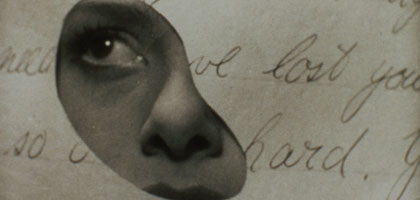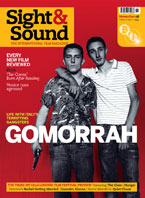Love Letters and Live Wires Highlights from the GPO Film Unit
UK 1936

Reviewed by Michael Brooke
Synopsis
Our synopses give away the plot in full, including surprise twists.
A compilation of eight films made by the GPO Film Unit between 1936 and 1939.
In N or NW, the relationship between feuding couple Jack and Evelyn is almost sundered when he puts the wrong postcode on a conciliatory letter, but a sharp-eyed postman corrects it. Love on the Wing depicts a letter metamorphosing into various human, animal and object shapes before announcing current postal rates. In The Fairy of the Phone, a fairy delivers an illustrated lecture on the niceties of telephone etiquette. The Horsey Mail shows how the post was delivered to the Norfolk village of Horsey after it was cut off by floods. Trade Tattoo features abstract impressions of how the rhythm of trade is maintained by the GPO's postal services. In A Midsummer Day's Work, an underground telephone cable is laid from Amersham to Oxford via the Chiltern Hills as Britain basks in a glorious summer. In The Tocher, Angus wins the love of Rhona over the objections of her father, the laird, with the help of 'the wee folk' and the Post Office Savings Bank. Night Mail depicts the operations of the nightly postal special train from London to Glasgow.
Review
Released to coincide with the 75th anniversaries of both the BFI (restorer/compiler/distributor) and the GPO Film Unit (production company), Love Letters and Live Wires is a delightful eight-film compilation showcasing the Unit's considerable range and peculiar virtues.
Of its remarkable talent pool - W.H. Auden, Benjamin Britten, Alberto Cavalcanti, William Coldstream, Pat Jackson, Humphrey Jennings, Len Lye, Norman McLaren, Lotte Reiniger, Harry Watt and Basil Wright - only Jennings is missing, his GPO film Spare Time (1939) having featured in a recent BFI touring programme. Nor is there anything from the Unit's early years (covered by a concurrent BFI DVD release), while the understandable desire to acknowledge Lye, McLaren and Reiniger suggests that the GPO produced more animation than is in fact the case. But few are likely to complain.
In fact, Lye's N or NW (1937) is mostly live-action and a perfect scene-setter. Its story of a misplaced postcode fits the official brief and is enhanced with inventive superimpositions, Man Rayesque images of faces and lips peering through letters, and a strangely erotic close-up of leaves placed on female thighs as a primitive sun-blocker. There's more surreal eroticism in Norman McLaren's dazzling Love on the Wing (1938), setting his endlessly morphing animation (drawn directly on to celluloid) over scrolling landscapes reminiscent of Tanguy and de Chirico. The Postmaster General originally restricted its release, believing it to be disturbingly Freudian, but its status as McLaren's first fully achieved masterpiece is now rock-solid.
'Masterpiece' is scarcely the word for William Coldstream's The Fairy of the Phone (1936), but its off-the-scale camp value more than compensates. Even the eponymous fairy's headmistress-like lessons in moronically elementary telephone usage are quirkily charming, and the song-and-dance numbers are a reminder that the 1930s saw the zenith of the British studio musical.
After this trio, the title The Horsey Mail (1938) suggests a lively anthropomorphic romp, but Pat Jackson's film is actually a moving (if resolutely stiff-upper-lipped) tribute to the GPO's resourcefulness in keeping the Norfolk village of Horsey connected to the rest of the world even after severe flooding. The sense of camaraderie is enhanced when the film's narrator briefly breaks off to join in with the postman's singing.
Len Lye returns in more characteristic form with Trade Tattoo (1937), turning footage of various industrial/trade processes into solarised near-abstractions overlaid with patterns of dots, lines and 35mm sprocket holes. It would be strongly rhythm-driven even without the Lecuona Band's percussive accompaniment.
Alberto Cavalcanti was the uncredited director of A Midsummer Day's Work (1939), an account of the laying of underground telephone cables between Amersham and Oxford that's also a bucolic portrait of a lazy English summer, blithely undisrupted by essential engineering work. The year of production makes it the quintessence of the calm before the storm.
The Tocher (1938) is a wordless 'film ballet' in Lotte Reiniger's signature silhouette style - which proves well matched to this Scottish folktale, if only for the carefully delineated outlines of the laird's kilt and garters. He's initially opposed to his daughter Rhona marrying young Angus but is mollified by a Post Office savings book donated by 'the wee folk'. This could be repellently twee but Reiniger's elegant treatment has a timeless serenity that proves quite disarming.
And finally there's Harry Watt and Basil Wright's masterly Night Mail (1936), which needs little introduction - except to note that the complete film (as opposed to the final iconic Auden-scripted Britten-scored sequence) is as much a tribute to a deceptively casual 'Britishness' as it is to the mechanical and logistical efficiency essential to the running of the London-to-Glasgow postal express. In that respect it not only sums up the GPO Film Unit's gentleman amateur ethos but also makes a fair stab at encapsulating an entire national identity. That's no mean achievement for any film, let alone a corporate promo.
Credits
- Production Companies
- Presented by the BFI in partnership with Royal Mail, The British Postal Museum & Archive and BT Heritage
- N or NW
- United Kingdom 1937
- Direction Len Lye
- Produced by The G.P.O. Film Unit
- Supervision A. [Alberto] Cavalcanti
- Camera Jonah Jones
- Sound Editor Jack Ellitt
- Cast Evelyn Corbett, Evelyn Meredith, Dwight Godwin, Jack
- Love on the Wing
- United Kingdom 1938
- By Norman McLaren
- Production Company A GPO film
- Producer* Alberto Cavalcanti
- Camera Jonah Jones, F. [Fred] Gamage
- Music from Jacques Ibert's "Divertissement"
- Sound System RCA Ultra-Violet Recording
- The Fairy of the Phone
- United Kingdom 1936
- Direction William Coldstream
- Production Company A GPO film
- Production Basil Wright
- Camera James Rogers
- Music Walter Leigh
- Songs* Basil Wright
- Sound C. Sullivan
- Recorded on Visatone-Marconi
- Cast Charlotte Leigh, The Fairy of the Phone members of the London Telephone Service
- The Horsey Mail
- United Kingdom 1938
- Direction Patrick Jackson
- Produced by the GPO Film Unit
- Camera F. [Fred] Gamage
- Music Victor Yates
- Cast Bob O'Brian, Claude Simmonds postmen
- Trade Tattoo The rhythm of work-a-day Britain.
- United Kingdom 1937
- By Len Lye
- Production Company John Grierson presents a G.P.O Film Unit production
- Music Editor Jack Ellitt
- Music Played by The Lecuona Band
- Sound Visatone-Marconi
- A Midsummer Day's Work
- United Kingdom 1939
- Director* Alberto Cavalcanti
- Produced by the G.P.O. Film Unit
- Producer* Alberto Cavalcanti
- Assistant [Director] D. Knight
- Camera Jonah Jones, James E. Rogers
- Editor R. [Richard] Q. McNaughton
- Music Arranged by J.E.N. Cooper
- Sound K. [Ken] Cameron
- Sound System RCA Ultra-Violet Recording
- The Tocher
- United Kingdom 1938
- A Film ballet by Lotte Reiniger
- Production Company A GPO Film Unit production
- Collaborator Martin Battersby
- Animator Lotte Reiniger
- Rossini Themes Arranged by Benjamin Britten
- Sound Visatone-Marconi
- Night Mail
- United Kingdom 1936
- Production Companies The G.P.O. Film Unit presents
- An A.B.F.D. release
- Produced by Basil Wright, Harry Watt


